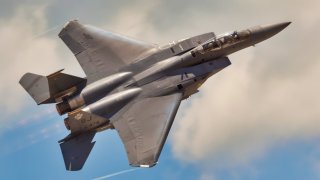The F-15 Fighter Did The Unthinkable: It Could Land with Just 1 Wing
On May 1, 1983, an Israeli Air Force F-15D Eagle survived a mid-air collision with an A-4 Skyhawk during a training exercise over southern Israel.
Summary and Key Points: On May 1, 1983, an Israeli Air Force F-15D Eagle survived a mid-air collision with an A-4 Skyhawk during a training exercise over southern Israel.
-The F-15's right wing was almost completely sheared off. Despite this, pilot Zivi Nedivi managed to regain control of the aircraft by engaging the afterburner and made an emergency landing at Ramon Air Base. The incident highlighted the F-15's robust design, with engineers later noting its wide lifting body.
-The damaged F-15 was repaired and returned to action, eventually downing another Syrian MiG-23 in 1985.
How an F-15 Eagle Survived a Mid-Air Collision With Only One Wing
The twin-engine, all-weather McDonnell Douglas F-15 Eagle has proven to be an unstoppable tactical fighter. It has more than 100 aerial victories and not a single loss in aerial combat, and while there have been a total of 175 Eagles that crashed, it is a very reliable aircraft with only one loss per 50,000 flight hours. In fact, the only reason any F-15s have been lost has been due to human error, ground incidents, or other situations that have nothing to do with air combat.
In one incident, an F-15 Eagle was even able to return to base with its right wing nearly sheared off. Despite the extreme damage, the pilot was able to reach a nearby airbase and land safely. Remarkably, that Eagle had its wing repaired (rather than clipped for good) and it returned to action and even took part in combat operations.
The Mid-Air Collision and Survival
The incident occurred on May 1, 1983, when an Israeli Air Force F-15D collided mid-air with an A-4 Skyhawk during an airfield defense training exercise over the Negev region of southern Israel.
As previously reported by The National Interest, elements of the Israeli Air Force’s 106th and 116th squadrons took to the skies with the F-15D Baz (Hebrew for "Falcon," the Israeli name for the F-15) playing the role of defenders, and the A-4s serving as aggressors. The Skyhawks were dated attack aircraft by that point and posed little threat to an F-15 in a one-on-one fight, but they had both numbers and experience on their side. One of the two F-15 Baz fighters taking part in the exercise was pilot Zivi Nedivi, who was still training to fly the powerful F-15 under the tutelage of Yehoar Gal, an experienced Baz aviator in the rear seat.
During training, pilots typically maintain a "safety bubble" of 500 feet or more to ensure that aircraft collisions don't occur during the high-speed maneuvering inherent to dogfighting – aka Basic Fighter Maneuvers (BFM). No aircraft should enter another plane's safety bubble, but when they do, big things happen, and they did forty one years ago this month.
The A-4 collided with the F-15D Baz, and the pilot of the Skyhawk was automatically ejected as his aircraft disintegrated. The right wing of the Baz was sheared off with just two feet remaining. The aircraft immediately went into a downward spin and neither Nedivi – who attempted to regain control of the fighter – nor his instructor Gal knew the extent of the damage to their aircraft. Nedivi, who outranked the instructor, opted not to eject. Instead, he attempted recovery by engaging the afterburner and eventually regained control of the aircraft.
The pilot was able to retain control of the F-15 but only with the application of additional power, and he immediately headed towards Ramon Air Base to make an emergency landing.
"A normal approach is around 130 knots, but we made ours at around 250 to 260 knots, about twice that of a normal landing. As a result of this I put down the F-15's emergency arrestor hook which engaged the cable around a third of the way down the runway. We hit that, but the speed we were going meant that the hook itself tore off the aircraft and we eventually stopped 20 feet short of the barrier at the other end of the runway," Nedivi explained in Bertie Simmond's book "F-15 Eagle," per TheAviationGeekClub.
Only after exiting the aircraft on the ground did Nedivi see that the plane had literally lost its wing – and he later told The History Channel that had he known, he would have ejected! Engineers at McDonnell Douglas later analyzed the damaged warbird and acknowledged it had a very wide lifting body that if blown fast enough it is essentially a rocket!
That F-15, which had already claimed four enemy aircraft during the 1982 Lebanon War, was repaired and was able to successfully down another Syrian MiG-23 in November 1985.
Author Experience and Expertise: Peter Suciu
Peter Suciu is a Michigan-based writer. He has contributed to more than four dozen magazines, newspapers, and websites with over 3,200 published pieces over a twenty-year career in journalism. He regularly writes about military hardware, firearms history, cybersecurity, politics, and international affairs. Peter is also a Contributing Writer for Forbes and Clearance Jobs. You can follow him on Twitter: @PeterSuciu. You can email the author: [email protected].


